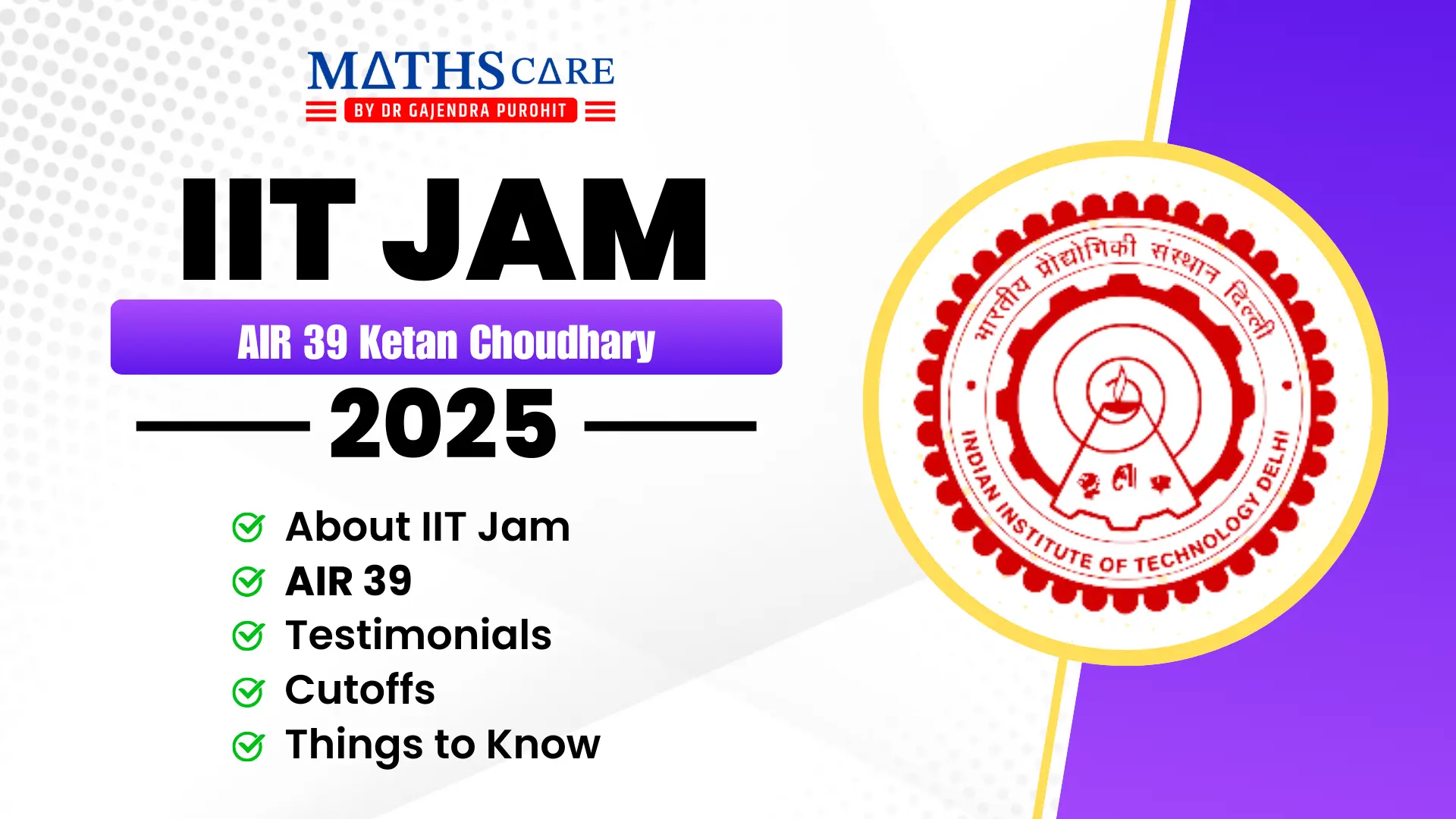IIT JAM Mathematics Mock Tests
The IIT JAM (Joint Admission Test for Masters) is one of the most competitive exams for postgraduate admissions in India’s premier institutes, including IITs, IISc, and NITs. For aspirants aiming to crack IIT JAM Mathematics in 2025, mock tests play a pivotal role in their preparation. These tests are more than just practice; they simulate the actual exam environment, gauge your readiness, and help fine-tune your strategy.
In this in-depth blog, we’ll explore every detail you need to know about preparing for IIT JAM Mathematics 2025, including the test pattern, syllabus, paper structure, availability of official mock tests, and actionable tips for attempting mocks effectively. Let’s dive into it!

IIT JAM Test Pattern
IIT JAM exam tests your foundational knowledge and problem-solving skills at the undergraduate level. It is conducted in a Computer-Based Test (CBT) format, making it essential for students to familiarize themselves with the system through mock tests. Below are the key highlights of the JAM 2025 test pattern:
Mode of Exam: Online (CBT).
Duration: 3 hours.
Language: English.
Total Marks: 100.
Question Types:
Multiple Choice Questions (MCQs): These have one correct option and include negative marking for incorrect answers.
Multiple Select Questions (MSQs): These have multiple correct answers and no negative marking.
Numerical Answer Type (NAT): For these, you must calculate and input the answer directly. No negative marking is applied.
IIT JAM Marking Scheme
The Mathematics paper is divided into three sections, each contributing to the total score:
1. Section A (MCQs)
Contains 30 questions.
Marking: 10 questions for 1 mark each and 20 questions for 2 marks each.
Penalty: -1/3 for 1-mark questions and -2/3 for 2-mark questions.
2. Section B (MSQs)
Contains 10 questions worth 2 marks each.
No negative marking.
All correct choices must be selected to score full marks; partial marks are not awarded.
3. Section C (NATs)
Contains 20 questions, with 10 for 1 mark each and 10 for 2 marks each.
No negative marking.
A total of 60 questions contribute to 100 marks, with the highest emphasis on Sections A and C. Familiarizing yourself with this structure is crucial for excelling in the exam.
IIT JAM Mathematics Syllabus
The Mathematics syllabus for IIT JAM is comprehensive, covering a wide range of undergraduate topics. Students must focus on three major areas:
1. Real Analysis
Sequences and Series: Limits of sequences, monotone convergence, and tests for series convergence (e.g., comparison test, ratio test, root test).
Functions: Continuity, differentiability, and applications of the mean value theorem.
Riemann Integration: Fundamental theorem of calculus, improper integrals, and integration by parts.
2. Linear Algebra and Algebra
Matrix Theory: Determinants, rank, eigenvalues, eigenvectors, and diagonalization.
Vector Spaces: Basis, dimension, linear independence, and transformations.
Group Theory: Subgroups, cyclic groups, Lagrange’s theorem, and normal subgroups.
3. Multivariable Calculus and Differential Equations
Partial Derivatives: Chain rule, Jacobians, maxima, and minima.
Multiple Integrals: Double and triple integrals, surface integrals, and volume calculations.
Differential Equations: First-order linear equations, systems of equations, and Cauchy-Euler equations.
Completing the syllabus with conceptual clarity is a prerequisite before attempting mock tests.
Paper Structure for IIT JAM Mathematics
Understanding the paper structure of IIT JAM Mathematics is crucial for devising a strategic approach to the exam. The paper is divided into three sections, each designed to test different problem-solving abilities. Section A consists of Multiple Choice Questions (MCQs), with a total of 30 questions carrying 50 marks. This section includes negative marking, making accuracy a priority. Section B comprises 10 Multiple Select Questions (MSQs), contributing 20 marks, where multiple correct answers are possible, and no negative marking is applied. Finally, Section C includes 20 Numerical Answer Type (NAT) questions, worth 30 marks, requiring candidates to input exact answers without the fear of penalties for incorrect responses. Overall, the JAM Mathematics paper emphasizes both speed and precision, and understanding this structure can help aspirants manage their time effectively and maximize their scores during the test.
IIT JAM 2025 Official Mock Tests
The organizing institute (IIT Delhi for 2025) releases official mock tests, which are indispensable resources for aspirants. Here’s why:
Simulated Exam Interface: These tests replicate the exact format and interface of the actual exam.
Time-Bound Practice: Practice adhering to the 3-hour time limit to improve speed and time management.
Sectional Navigation: Get accustomed to switching between sections and using features like mark-for-review.
Identifying Weaknesses: Detailed analysis post-mock helps in spotting areas needing improvement.
Official mock tests are available on the IIT JAM 2025 website, and aspirants are encouraged to take them multiple times.
IIT JAM Mathematics Mock Tests
Mock tests should be approached with a clear strategy. Follow these tips to make the most of your practice sessions:
Before the Mock Test
Prepare Thoroughly:
Before diving into full-length mock tests, ensure that you have completed the entire syllabus. This comprehensive preparation builds confidence and minimizes the likelihood of encountering unfamiliar topics during the mocks. Pay extra attention to your weak areas and frequently revise key formulas, theorems, and concepts to solidify your understanding. A well-rounded preparation strategy enables you to maximize the benefits of mock tests.
Choose a Quiet Space:
Select a noise-free and distraction-free environment to take your mock tests. This simulates the actual exam setting and helps you stay focused. Avoid areas with frequent interruptions, and ensure that the space is equipped with everything you might need during the test, such as a laptop, paper for rough work, and a comfortable chair and desk.
Time Your Test:
Mock tests should be completed within the same 3-hour duration as the actual exam. Strictly adhering to this time limit enhances your stamina and helps you gauge your speed in solving different types of questions. This practice also trains you to manage time effectively, especially when dealing with lengthy calculations or challenging problems.
Keep Allowed Materials Only:
During the JAM exam, you’ll only be allowed to use a virtual calculator, so it’s essential to practice with this tool during your mocks. Avoid using physical calculators or additional resources like reference books and notes. This restriction ensures that your mock tests closely replicate the conditions of the actual exam and prevent reliance on external aids.
Mock at the Same Time as the Exam:
Practice taking mock tests during the same time slot as your actual exam to condition your body and mind. For instance, if your paper is scheduled in the forenoon session from 9:30 AM to 12:30 PM, take your mock tests during this time. This approach helps in establishing a consistent routine, ensuring peak alertness and performance during the actual test.
During the Mock Test
Start with Your Strengths:
Begin the test by solving questions from topics you are most confident in. This strategy builds momentum, boosts morale, and saves time for tougher sections later. Successfully answering easier questions early on sets a positive tone for the rest of the test and ensures you don’t miss out on marks from your strong areas.
Don’t Waste Time:
Avoid spending too much time on a single question, especially if it seems challenging or time-consuming. Instead, skip such questions temporarily and revisit them later if time permits. This prevents bottlenecks and allows you to focus on maximizing your score by answering more manageable questions first.
Use the Mark-for-Review Feature:
For questions you find tricky or require additional time to solve, use the mark-for-review feature available in the JAM exam interface. This feature ensures you can easily locate these questions later, allowing you to allocate remaining time strategically without losing track of skipped questions.
Focus on Accuracy:
While attempting questions, prioritize accuracy over speed. Random guessing, especially in MCQs with negative marking, can significantly lower your score. Only answer when you are reasonably confident about the solution. For MSQs and NATs, where there is no negative marking, you can take calculated risks if necessary.
Stay Calm:
Maintaining composure throughout the test is vital. Nervousness or frustration can lead to silly mistakes, which can be avoided by staying relaxed. Take a few deep breaths if you feel stressed, and remind yourself that it’s just a practice test, aimed at improving your skills and preparation.
After the Mock Test
Review Every Question:
Post-test analysis is as important as the test itself. Carefully review each question, especially those you answered incorrectly or left unanswered. Analyze your thought process and identify whether the error was due to a conceptual misunderstanding, careless mistake, or time pressure. This reflection helps in refining your approach to similar questions in future tests.
Assess Weaknesses:
Identify the topics where you lost marks and categorize them based on difficulty and importance. Focus on revising these areas thoroughly. For example, if you struggle with certain topics in real analysis or linear algebra, revisit the relevant concepts and solve additional practice problems.
Record Your Scores:
Maintain a detailed log of your mock test performances, including your scores, accuracy rates, and time management. This record allows you to track your progress over time and identify patterns, such as consistent improvement or areas requiring more attention.
Adjust Your Study Plan:
Based on your mock test results, modify your preparation strategy. Allocate more time to challenging topics, adjust your question-solving sequence, and plan additional practice sessions for weak areas. Continuously fine-tuning your study plan ensures steady improvement and readiness for the actual exam.
Why Mock Tests for IIT JAM 2025 Success
Mock tests are not just practice tools but also invaluable confidence boosters. Here’s why they are an essential part of IIT JAM 2025 preparation:
Real-Time Practice:
Mock tests replicate the exact conditions of the actual exam, helping you become familiar with the interface, question patterns, and time constraints. Regular practice under exam-like settings reduces the likelihood of surprises on the final day.
Speed and Accuracy:
Solving a diverse set of questions within a limited timeframe improves your speed and accuracy. Mock tests teach you to balance quick thinking with careful problem-solving, which is crucial for scoring well in IIT JAM Mathematics.
Identify Weak Areas:
By analyzing your performance after each mock test, you can pinpoint the topics or question types where you struggle the most. This awareness allows you to focus on targeted improvement, enhancing your overall preparation.
Stress Reduction:
Mock tests build confidence by familiarizing you with the exam pattern and conditions. As a result, you feel more prepared and less anxious during the actual exam. Repeated exposure to time-bound testing conditions also enhances your mental resilience.
Refined Strategy:
Each mock test provides insights into what works best for you, such as the ideal order for attempting questions, time allocation for different sections, and strategies for tackling tricky problems. By refining your test-taking strategy through practice, you maximize your chances of success on the exam day.
Mock tests are indispensable tools for IIT JAM preparation. Incorporating them into your study routine ensures a well-rounded, efficient, and confident approach to the exam.
By diligently practicing mock tests, you can ensure that you are fully prepared to tackle IIT JAM Mathematics.
Conclusion
IIT JAM Mathematics 2025 is a challenging exam that demands rigorous preparation and practice. Mock tests are your ultimate preparation ally, offering insights into your performance and helping you refine your exam strategy. Utilize the official mocks, analyze your mistakes, and work consistently toward improvement. With focused preparation and strategic use of mock tests, success is within reach. Start today, and make every mock count!
IIT JAM FAQS
Admit Card Release
Admit cards will be available online for download in January 2025. No hard copies will be sent.
Admit Card and Identity Document
Along with your Admit Card, you must bring an original and valid photo ID (Aadhaar, Passport, PAN, Voter ID, or Driving License for Indian candidates; valid Passport or similar ID for foreign nationals).
Soft Copy of Admit Card
Only hard copies of the Admit Card are allowed for entry. Soft copies on electronic devices will not be accepted.
How to check IIT JAM Application Status
You can check the status of your application on the JAM 2025 website.
IIT JAM Application Under Scrutiny
No action is needed until you are contacted for corrections if required. The scrutiny process continues even after the portal closes.
IIT JAM Sending a Print-out of the Application
You do not need to send a physical print-out of your application to any JAM institute.
BEST OFFERING COURSES FOR YOU
BEST BOOKS FOR IIT JAM/ CSIR-NET
BUY BOOKS ON OUR APP
RECENT POSTS

IIT JAM 2025 Topper: AIR 44 Saheb Dhar

IIT JAM 2025 Topper: AIR 39 Ketan Choudhary

IIT JAM 2025 Topper: AIR 116 Hitendra Kumar








